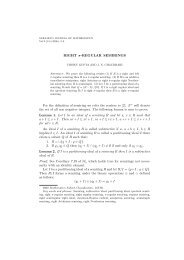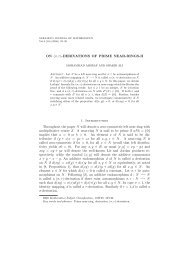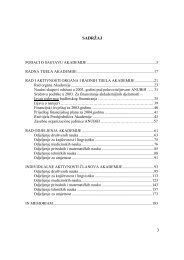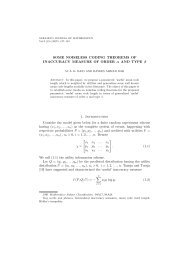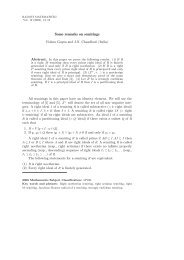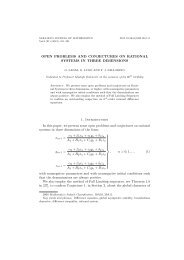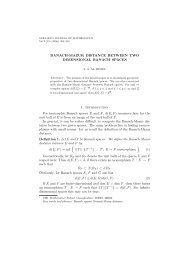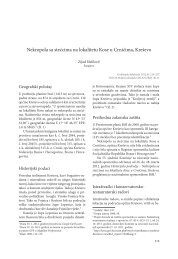Takashi Noiri and Valeriu Popa - anubih
Takashi Noiri and Valeriu Popa - anubih
Takashi Noiri and Valeriu Popa - anubih
You also want an ePaper? Increase the reach of your titles
YUMPU automatically turns print PDFs into web optimized ePapers that Google loves.
132 TAKASHI NOIRI AND VALERIU POPADefinition 3.4. Let (Y, σ) be a topological space. A function f : (X, m X ) →(Y, σ) is said to be m-continuous [33] at x ∈ X if for each open set V containingf(x), there exists U ∈ m X containing x such that f(U) ⊂ V . Thefunction f is said to be m-continuous if it has this property at each pointx ∈ X.Theorem 3.1. (<strong>Popa</strong> <strong>and</strong> <strong>Noiri</strong> [33]). For a function f : (X, m X ) → (Y, σ),the following properties are equivalent:(1) f is m-continuous;(2) f −1 (V ) = mInt(f −1 (V )) for every open set V of Y;(3) f −1 (F ) = mCl(f −1 (F )) for every closed set F of Y;(4) mCl(f −1 (B)) ⊂ f −1 (Cl(B)) for every subset B of Y;(5) f(mCl(A)) ⊂ Cl(f(A)) for every subset A of X;(6) f −1 (Int(B)) ⊂ mInt(f −1 (B)) for every subset B of Y.Corollary 3.1. (<strong>Popa</strong> <strong>and</strong> <strong>Noiri</strong> [33]). For a function f : (X, m X ) → (Y, σ),where m X has property B, the following properties are equivalent:(1) f is m-continuous;(2) f −1 (V ) is m X -open in X for every open set V of Y;(3) f −1 (F ) is m X -closed in X for every closed set F of Y.Definition 3.5. A function f : (X, m X ) → (Y, σ) is said to be m ∗ -continuous[20] if f −1 (V ) is m X -open in X for each open set V of Y .Remark 3.4.(1) If f : (X, m X ) → (Y, σ) is m ∗ -continuous, then it is m-continuous.By Example 3.4 of [20], every m-continuous function may not bem ∗ -continuous.(2) Let m X have property B, then it follows from Corollary 3.1 that fis m-continuous if <strong>and</strong> only if f is m ∗ -continuous.For a function f : (X, m X ) → (Y, σ), we define D m (f) as follows:D m (f) = {x ∈ X : f is not m-continuous at x}.Theorem 3.2. (<strong>Popa</strong> <strong>and</strong> <strong>Noiri</strong> [34]). For a function f : (X, m X ) → (Y, σ),the following properties hold:D m (f) = ∪ G∈σ {f −1 (G) − mInt(f −1 (G))}= ∪ B∈ P (Y ) {f −1 (Int(B)) − mInt(f −1 (B))}= ∪ B∈ P (Y ) {mCl(f −1 (B)) − f −1 (Cl(B))}= ∪ A∈ P (X) {mCl(A) − f −1 (Cl(f(A)))}= ∪ F ∈ F {mCl(f −1 (F )) − f −1 (F )},where F is the family of closed sets of (Y, σ).



